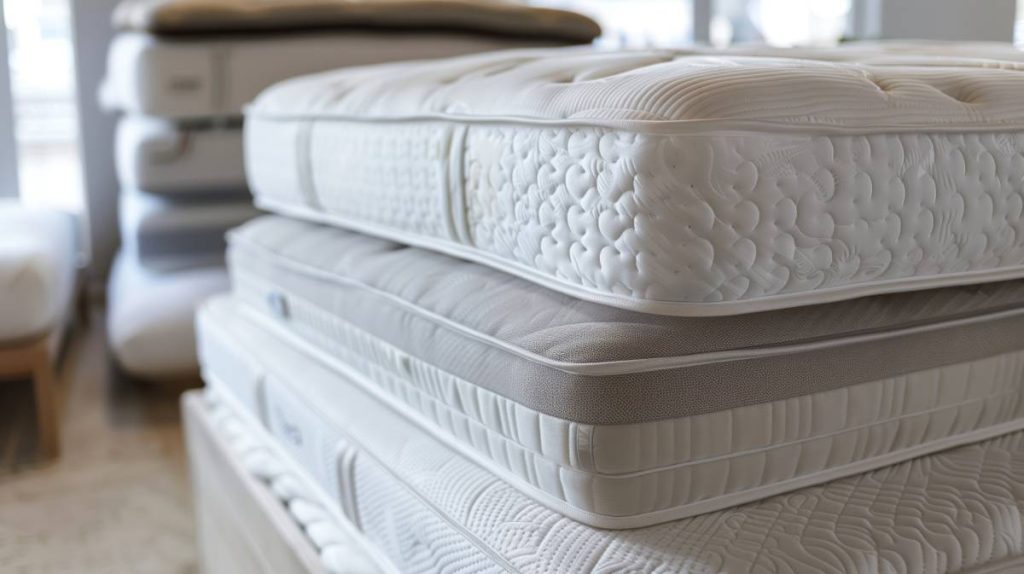Let’s talk about something we all adore but might not always get enough of—sleep. Quality sleep isn’t just about feeling rested; it’s a cornerstone of our overall health and well-being.
When we sleep well, our bodies repair, our minds refresh, and we’re ready to tackle whatever the day throws at us. But how do we achieve that elusive good night’s sleep? Well, it turns out that the mattress you sleep on plays a significant role.
Your mattress isn’t just a place to crash at the end of a long day. It’s a vital component that affects your sleep posture, comfort, and even how cool or warm you feel throughout the night. The right mattress can make a world of difference, transforming restless nights into peaceful slumber.
In this article, we’re diving deep into the science behind the best mattresses. We’ll explore how different materials and designs can enhance your sleep quality and help you wake up feeling rejuvenated. So, are you ready to discover how you can sleep better tonight? Let’s get started!
Understanding Sleep and Its Importance
Hey there! Let’s dive into the fascinating world of sleep and why it’s so crucial for our overall well-being. Sleep isn’t just about closing your eyes and drifting off; it’s a complex process that plays a vital role in our health.
Sleep Cycles and Stages
First off, let’s break down the sleep cycles and stages. Our sleep is divided into two main types: REM (Rapid Eye Movement) and non-REM sleep. Non-REM sleep is further split into three stages:
- Stage 1: This is the lightest stage of sleep, where you drift in and out of sleep and can be awakened easily. It’s kind of like the warm-up act before the main event.
- Stage 2: Here, your body temperature drops, and your heart rate starts to slow down. It’s a deeper sleep than Stage 1, but you’re not quite in the deep sleep territory yet.
- Stage 3: This is the deep sleep stage, essential for feeling refreshed in the morning. During this stage, your body repairs tissues, builds bone and muscle, and strengthens the immune system.
Then we have REM sleep, where dreaming happens, and your brain is almost as active as when you’re awake. This stage is crucial for cognitive functions like memory consolidation and learning.
Impact of Sleep on Physical and Mental Health
Now, let’s talk about how all this affects your health. Quality sleep is like a magic potion for your body and mind. Physically, good sleep boosts your immune system, speeds up recovery from illness or injury, and even helps regulate your metabolism.
Mentally, sleep is a superhero for your brain. It aids in mood regulation, meaning you’re less likely to wake up grumpy if you’ve had a good night’s rest. It also enhances cognitive functions like attention, decision-making, and creativity. Ever noticed how everything seems a bit foggy when you’re sleep-deprived? That’s your brain crying out for some quality shut-eye.
Common Sleep Disorders and Their Effects
Unfortunately, not everyone gets the sleep they need. Common sleep disorders can throw a wrench in your night’s rest and have significant impacts on your health. Let’s look at a few:
- Insomnia: This is the inability to fall or stay asleep. It can lead to chronic fatigue, mood disturbances, and difficulty concentrating.
- Sleep Apnea: This disorder causes your breathing to repeatedly stop and start during sleep, leading to interrupted sleep and reduced oxygen levels. It can result in daytime fatigue, cardiovascular problems, and even severe health issues if left untreated.
- Restless Leg Syndrome (RLS): This causes an uncontrollable urge to move your legs, usually because of discomfort. It can make falling asleep a real challenge and lead to daytime drowsiness.
Understanding these aspects of sleep can help you appreciate why investing in a good mattress is so important. The right mattress supports your body through these sleep stages, helping you avoid or alleviate some of these common sleep issues.
So, the next time you think about hitting the sack, remember: understanding sleep can make all the difference in achieving that perfect night’s rest. Ready to learn more about how the best mattresses can help? Stick around!
The Role of Mattresses in Sleep Quality
Hey there! Ready to dive deeper into how your mattress can make or break your sleep quality? A good mattress isn’t just a luxury; it’s a necessity for anyone wanting to wake up refreshed and ready to tackle the day. Let’s explore how your mattress plays a crucial role in this.
How Mattresses Affect Sleep Posture and Alignment
First up, let’s talk about sleep posture and alignment. Your mattress should support your body in a neutral position, where your spine maintains its natural curve. This is essential for preventing aches and pains. Imagine trying to sleep on a wooden board—uncomfortable, right? Similarly, a too-soft mattress can cause your body to sink, leading to poor alignment and discomfort.
A good mattress provides the right amount of support to keep your spine in alignment, whether you’re a back, side, or stomach sleeper. For back sleepers, the mattress should support the natural curve of your lower back. Side sleepers need a mattress that aligns with their body’s contours to relieve pressure on the hips and shoulders. Stomach sleepers require a firmer surface to prevent the lower back from arching unnaturally.
The Relationship Between Mattress Firmness and Comfort
Now, let’s tackle the age-old question: firm or soft? The answer isn’t one-size-fits-all. Mattress firmness is a key factor in comfort and significantly varies from person to person.
- Soft Mattresses: Ideal for side sleepers who need to cushion their shoulders and hips. However, too soft can mean lack of support.
- Medium-Firm Mattresses: Often recommended for back sleepers as they provide a balance of support and comfort.
- Firm Mattresses: Best for stomach sleepers or those who need extra spinal support. However, too firm can lead to pressure points and discomfort.
Your body type also plays a role. Heavier individuals may prefer a firmer mattress to prevent sinking, while lighter individuals might find softer options more comfortable.
Importance of Mattress Materials in Temperature Regulation
Lastly, let’s not forget about temperature regulation. Nobody likes waking up in a pool of sweat. The materials used in your mattress can significantly impact how cool or warm you feel during the night.
- Memory Foam: Known for its contouring properties, but can sometimes retain heat. Look for options infused with cooling gel to mitigate this.
- Latex: Naturally breathable and offers excellent temperature regulation. It’s also hypoallergenic, making it a great choice for allergy sufferers.
- Innerspring: These mattresses have coils that allow for better airflow, keeping you cooler throughout the night.
- Hybrid: Combining foam and springs, hybrid mattresses offer the best of both worlds—support, comfort, and temperature regulation.
Understanding these factors can help you choose a mattress that not only supports your body but also keeps you comfortable temperature-wise.
So, there you have it! Your mattress is more than just a place to sleep—it’s a vital component in achieving good sleep quality. Ready to find out how to pick the perfect mattress for you? Keep reading!
Scientific Insights into Mattress Design
Hey there! If you’ve ever wondered what goes into designing the perfect mattress, you’re in the right place. Let’s delve into the science behind mattress design and see how it can transform your sleep experience.
Ergonomic Design Principles in Mattresses
To start, let’s talk about ergonomic design. Ergonomics is all about creating products that fit the human body, and mattresses are no exception. A well-designed mattress supports your body’s natural alignment, ensuring your spine stays in a neutral position. This is crucial for preventing aches and pains.
When it comes to mattresses, ergonomic design focuses on:
- Spinal Support: Ensuring the mattress supports the natural curve of your spine, from head to toe.
- Pressure Relief: Distributing body weight evenly to alleviate pressure points, particularly around the hips and shoulders.
- Motion Isolation: Minimizing movement across the bed, so your partner’s tossing and turning doesn’t disturb your sleep.
These principles help create a sleep environment that promotes restorative sleep and reduces discomfort.
The Role of Technology and Innovation in Mattress Development
Next up, let’s explore the role of technology and innovation in mattress development. Gone are the days when a mattress was just a slab of foam or springs. Today’s mattresses are packed with cutting-edge features designed to enhance your sleep.
- Smart Mattresses: These high-tech beds come with built-in sensors that track your sleep patterns, heart rate, and even breathing. Some can adjust their firmness based on your sleep position or provide gentle vibrations to wake you up during the lightest sleep phase.
- Adjustable Bases: These allow you to customize your sleeping position with the touch of a button. Whether you need to elevate your head to alleviate snoring or raise your legs for better circulation, adjustable bases offer personalized comfort.
- Cooling Technologies: From gel-infused foams to advanced airflow systems, modern mattresses are designed to regulate temperature and keep you cool throughout the night.
- Eco-friendly Materials: Innovations in sustainable materials mean you can choose mattresses made from organic or recycled materials, reducing your environmental footprint.
These advancements not only make mattresses more comfortable but also contribute to better sleep quality and overall health.
Studies and Research Findings on Mattress Effectiveness
Finally, let’s look at some studies and research findings that highlight the effectiveness of well-designed mattresses. Research consistently shows that the right mattress can significantly improve sleep quality and health outcomes.
- Spinal Alignment: Studies have found that mattresses designed to support spinal alignment can reduce back pain and improve sleep quality.
- Pressure Relief: Research indicates that mattresses with good pressure relief properties can alleviate discomfort and promote deeper, more restorative sleep.
- Temperature Regulation: Studies show that sleeping in a cool environment enhances sleep quality. Mattresses with advanced cooling technologies help maintain an optimal sleep temperature.
These insights underscore the importance of investing in a high-quality mattress designed with ergonomic principles and innovative technologies. By doing so, you’re not just buying a bed—you’re investing in better health and well-being.
So, the next time you think about upgrading your mattress, remember: there’s a lot of science and innovation behind that plush exterior. Ready to explore more about how the best mattresses can improve your sleep? Keep reading!
Types of Mattresses and Their Benefits

Hey there! Choosing the right mattress can feel like navigating a maze with so many options available. Let’s break it down and explore the different types of mattresses and their unique benefits to help you find your perfect match.
Memory Foam Mattresses
First up, memory foam mattresses. These are known for their incredible contouring support. Made from viscoelastic material, memory foam adapts to your body shape, providing personalized support and pressure relief.
Benefits:
- Contouring Support: Memory foam conforms to your body, offering excellent support and reducing pressure points, especially around the hips and shoulders.
- Motion Isolation: If you share your bed, memory foam can be a game-changer. It absorbs movement, so you won’t be disturbed by your partner’s tossing and turning.
- Pain Relief: Ideal for individuals with chronic pain or joint issues, as it provides targeted support and alleviates discomfort.
Considerations:
- Heat Retention: Traditional memory foam can trap heat, making it less suitable for hot sleepers. However, some modern versions come with cooling gel infusions to address this issue.
- Initial Odor: New memory foam mattresses may emit a temporary off-gassing smell, which usually dissipates within a few days.
Innerspring Mattresses
Next, let’s talk about innerspring mattresses. These are the traditional choice for many and have come a long way with modern updates.
Benefits:
- Support and Durability: Innerspring mattresses are known for their robust support and durability, thanks to the network of metal coils inside.
- Breathability: The open coil structure allows for better airflow, which helps keep you cool throughout the night.
- Variety: With options ranging from firm to plush, there’s an innerspring mattress for every preference.
Modern Updates:
- Pillow Tops: Many innerspring mattresses now come with a plush pillow top layer for added comfort.
- Individually Pocketed Coils: Modern designs often feature individually pocketed coils that move independently, reducing motion transfer and offering better support.
Latex Mattresses
Moving on to latex mattresses, these are made from natural or synthetic latex and are known for their durability and eco-friendliness.
Benefits:
- Natural Materials: Natural latex is derived from rubber tree sap, making it an excellent eco-friendly option.
- Durability: Latex mattresses are incredibly durable and can last up to 15 years with proper care.
- Responsiveness: Unlike memory foam, latex has a more responsive feel, providing support without the “sinking” sensation.
Considerations:
- Firmness: Latex mattresses tend to be on the firmer side, which may not suit everyone.
- Allergies: Natural latex is hypoallergenic and resistant to dust mites and mold, making it great for allergy sufferers.
Hybrid Mattresses
Last but not least, hybrid mattresses combine the best features of different materials to offer optimal support and comfort.
Benefits:
- Versatility: Hybrids typically combine innerspring coils with memory foam or latex, offering a balanced mix of support, comfort, and pressure relief.
- Enhanced Support: The coil base provides strong support and durability, while the foam or latex layers add contouring and comfort.
- Temperature Regulation: Many hybrid mattresses incorporate cooling technologies to help regulate temperature, making them a good choice for hot sleepers.
Considerations:
- Weight: Hybrids can be heavier than other types due to the combination of materials, making them harder to move.
- Cost: They can be more expensive, but the investment often pays off in terms of comfort and longevity.
So, whether you prefer the contouring support of memory foam, the traditional feel of innerspring, the natural durability of latex, or the balanced comfort of a hybrid, there’s a mattress out there to meet your needs. Ready to find your perfect sleep companion? Keep reading!
Choosing the Right Mattress for You
Hey there! So, you’re ready to find the perfect mattress, but the options seem endless, right? No worries! Let’s break down the key factors you need to consider to make an informed decision that suits your unique needs.
Factors to Consider: Body Type, Sleeping Position, and Personal Preferences
When choosing a mattress, it’s essential to consider your body type, sleeping position, and personal preferences. Here’s a quick guide to help you navigate these factors:
Body Type:
- Lighter Individuals: Generally, lighter people (under 130 lbs) may find softer mattresses more comfortable, as they don’t sink as deeply into firmer options.
- Average Weight: If you fall between 130-230 lbs, a medium-firm mattress often provides the right balance of support and comfort.
- Heavier Individuals: People over 230 lbs might prefer firmer mattresses to prevent excessive sinking and ensure proper spinal alignment.
Sleeping Position:
- Back Sleepers: Look for a mattress that supports the natural curve of your spine. Medium-firm mattresses are usually a good fit, offering the right mix of support and comfort.
- Side Sleepers: You’ll want a mattress that relieves pressure on your shoulders and hips. Softer to medium-firm mattresses can provide the necessary cushioning.
- Stomach Sleepers: A firmer mattress helps keep your spine aligned and prevents your lower back from arching too much.
- Combination Sleepers: If you switch positions throughout the night, a medium-firm mattress with good responsiveness can accommodate your movements.
Personal Preferences:
- Firmness Level: Your comfort is paramount. Whether you prefer a cloud-like softness or a firmer feel, make sure the mattress matches your comfort level.
- Temperature Regulation: If you tend to sleep hot, look for mattresses with cooling technologies like gel-infused foams or breathable latex.
- Allergies: Hypoallergenic materials like natural latex or specific memory foams can be beneficial for allergy sufferers.
Tips for Testing Mattresses In-Store or Through Trials
Testing a mattress is crucial to ensure it meets your comfort and support needs. Here are some tips for both in-store and trial period testing:
In-Store Testing:
- Take Your Time: Don’t be shy—spend at least 10-15 minutes lying on each mattress in your typical sleep position.
- Focus on Comfort: Pay attention to how the mattress feels. Is it supportive and comfortable in all the right places?
- Ask Questions: Don’t hesitate to ask the salesperson about the materials, construction, and any specific concerns you have.
Trial Periods:
- Utilize the Trial: Many online retailers offer trial periods ranging from 90 to 365 nights. Use this time to test the mattress thoroughly.
- Track Your Sleep: Keep a sleep diary to note any changes in your sleep quality, comfort levels, and any aches or pains.
- Adjust if Needed: Some mattresses come with adjustable layers or firmness settings. Don’t hesitate to tweak these to find your perfect comfort level.
Importance of Warranties and Return Policies
Finally, let’s talk about warranties and return policies. Investing in a mattress is a significant decision, and having solid warranties and return policies can provide peace of mind.
- Warranties: Look for warranties that cover at least 10 years. These typically protect against defects in materials and workmanship. Make sure you understand what is and isn’t covered.
- Return Policies: A generous return policy allows you to return or exchange the mattress if it doesn’t meet your expectations. Many retailers offer hassle-free returns within the trial period, ensuring you’re not stuck with a mattress that isn’t right for you.
So there you have it! By considering your body type, sleeping position, and personal preferences, testing the mattress thoroughly, and understanding the importance of warranties and return policies, you’ll be well on your way to selecting the perfect mattress. Ready to dive deeper into the world of sleep science? Keep reading!
Maintaining Your Mattress for Longevity
Hey there! So you’ve found the perfect mattress—awesome! But to keep it in tip-top shape and ensure it lasts as long as possible, you’ll need to give it a little TLC. Let’s dive into some easy tips for cleaning and caring for your mattress, along with understanding when it might be time for a replacement.
Tips for Cleaning and Caring for Your Mattress
- Regular Vacuuming:
Your mattress can accumulate dust, dead skin cells, and even dust mites over time. Regularly vacuuming your mattress helps keep these at bay. Use a handheld vacuum or your vacuum’s upholstery attachment for best results. - Use a Mattress Protector:
A good mattress protector acts as a barrier against spills, stains, and allergens. It’s much easier to wash a protector than to clean a mattress, so this step can save you a lot of hassle in the long run. - Rotate Your Mattress:
To ensure even wear, rotate your mattress every three to six months. This helps prevent sagging and extends the life of the mattress. Some mattresses can also be flipped, but check the manufacturer’s guidelines first. - Spot Cleaning:
Accidents happen, and when they do, spot cleaning is essential. Use mild detergent and cold water to clean any stains immediately. Avoid soaking the mattress, as excessive moisture can lead to mold and mildew. - Air It Out:
Every few months, let your mattress breathe by removing the bedding and opening windows to allow fresh air to circulate. This can help prevent musty odors and keep your mattress fresh. - Avoid Jumping:
It might be fun, but jumping on the bed can damage the internal structure of your mattress. Keep heavy activities off the mattress to maintain its integrity.
How Often to Replace Your Mattress for Optimal Sleep Quality
Even with the best care, mattresses don’t last forever. Here’s when you should consider replacing your mattress to maintain optimal sleep quality:
- Wear and Tear:
Over time, mattresses can develop lumps, sagging, and other signs of wear and tear. If you notice these, it’s a clear signal that it’s time for a new mattress. - Changes in Comfort:
If you find yourself waking up with aches and pains that weren’t there before, your mattress might no longer be providing the support you need. As your body changes, your comfort needs can also change, necessitating a new mattress. - Allergies or Asthma:
Older mattresses can harbor allergens like dust mites, which can aggravate allergies or asthma. If you’re experiencing increased allergy symptoms, a new mattress might help improve your health and sleep quality. - Sleep Quality:
If you’re tossing and turning more than usual or not waking up feeling rested, your mattress could be the culprit. A good mattress should support restful, uninterrupted sleep. - Technology Advancements:
Mattress technology is continually evolving, with new materials and designs that can enhance sleep quality. If your mattress is more than 7-10 years old, you might benefit from upgrading to a model with the latest innovations.
By following these tips for cleaning and maintaining your mattress, and knowing when it’s time for a replacement, you’ll ensure that your sleep environment remains comfortable and supportive for years to come. Ready to dive even deeper into the world of sleep science? Keep reading!
Conclusion
Hey there! We’ve covered a lot of ground in exploring how the right mattress can dramatically impact your sleep quality and overall health. From understanding the role of mattresses in sleep posture and alignment to diving into the latest innovations in mattress design, it’s clear that investing in a quality mattress is more than just a luxury—it’s essential for your well-being.
Choosing the right mattress tailored to your body type, sleeping position, and personal preferences can make a world of difference. Remember, a good night’s sleep isn’t just about feeling rested; it’s about improving your overall health, mood, and productivity.
So, why wait? Start exploring your mattress options today and make sleep health a top priority. You’ll thank yourself every morning when you wake up refreshed and ready to conquer the day.
Ready to upgrade your sleep experience? Take the first step by exploring different mattress options and finding the perfect fit for you. Prioritize your sleep health and invest in a mattress that supports your journey to better rest and rejuvenation.
Additional Resources
For those who want to dive deeper into the science of sleep and mattress selection, here are some valuable resources:
- Studies and Articles on Sleep Science:
- The Impact of Mattress Types on Sleep Quality ([Link to study])
- Ergonomic Principles in Mattress Design ([Link to article])
- The Role of Technology in Modern Mattresses ([Link to study])
- Further Reading on Sleep Health and Mattress Selection:
- The Ultimate Guide to Choosing the Right Mattress ([Link to guide])
- How Sleep Affects Your Overall Health ([Link to article])
- Innovations in Mattress Technology and Their Benefits ([Link to article])
By tapping into these resources, you’ll be well-equipped to make informed decisions and enhance your sleep quality. Sweet dreams and here’s to better sleep tonight!





















